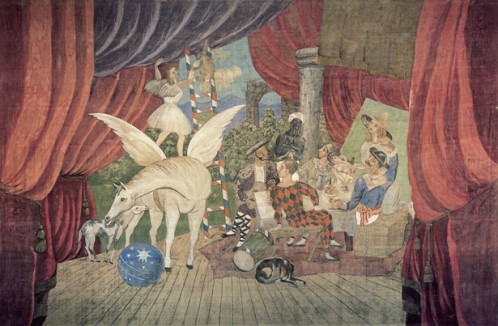1917
Metz
Centre Pompidou-Metz currently presents 1917, a multidisciplinary exhibition that investigates the fundamental question of artistic creation in wartime. Originating with Picasso’s creation of his largest work, the stage curtain for the ballet Parade, in 1917, the exhibition examines artistic production of that crucial year in light of historical facts and their impacts on the lives of the artists.
1917 offers an instant view of every field of creativity during this year of the First World War. It asks what such a narrow, precise context as a single year might mean for creative activity, while avoiding the pitfalls of expectations and assumptions as to the nature of wartime art. By focusing on one year in the 20th century, 1917 also explores a rarely attempted, original exhibition format.
Alongside masters such as Brancusi, Dix, Duchamp, Kandinsky, Matisse, Monet, or Nevinson, were amateur artists who felt the need to respond to the trials of war through creative expression such as Trench art, examples of which are a high point of the exhibition. Equally important are the war artists who were sent to the front to record its events, and the many individuals who, as eyewitnesses, expressed their memory of the conflict for posterity.
From physical and psychological destruction and rebuilding through self-portraiture, to the confusion between gender, and the transformation associated with camouflage, two major figures arise: the Harlequin and the stage curtain for the ballet Parade, whose monumental format and remarkable presentation constitute the climax of the exhibition. This masterpiece by Picasso was last shown in 2004 in Hong Kong and is shown in France for the first time in over twenty years.

![Félix Édouard Vallotton, Verdun Tableau de guerre interprêté [sic] projections colorées noires bleues et rouges terrains dévastés, nuées de gaz, 1917](http://wertical.com/wp-content/uploads/2012/05/felix_edouard_vallotton_verdun_0-e1337952872340.jpg)
May 26th – September 24th, 2012
1, parvis des Droits-de-l’Homme
57020 Metz Cedex 1
France
Archive
- Dezember 2016 (1)
- Oktober 2016 (3)
- September 2016 (24)
- Juli 2016 (20)
- Juni 2016 (24)
- Mai 2016 (18)
- April 2016 (18)
- März 2016 (21)
- Februar 2016 (11)
- Januar 2016 (20)
- Dezember 2015 (20)
- November 2015 (37)
- Oktober 2015 (30)
- September 2015 (24)
- August 2015 (4)
- Juli 2015 (30)
- Juni 2015 (9)
- Mai 2015 (17)
- April 2015 (23)
- März 2015 (18)
- Januar 2015 (8)
- Dezember 2014 (1)
- November 2014 (3)
- Oktober 2014 (10)
- September 2014 (4)
- August 2014 (2)
- Juli 2014 (3)
- Juni 2014 (2)
- Mai 2014 (5)
- April 2014 (11)
- März 2014 (12)
- Februar 2014 (13)
- Januar 2014 (10)
- Dezember 2013 (5)
- November 2013 (13)
- Oktober 2013 (24)
- September 2013 (18)
- August 2013 (26)
- Juli 2013 (13)
- Juni 2013 (35)
- Mai 2013 (44)
- April 2013 (49)
- März 2013 (61)
- Februar 2013 (54)
- Januar 2013 (46)
- Dezember 2012 (50)
- November 2012 (58)
- Oktober 2012 (62)
- September 2012 (61)
- August 2012 (63)
- Juli 2012 (64)
- Juni 2012 (61)
- Mai 2012 (63)
- April 2012 (51)
- März 2012 (67)
- Februar 2012 (37)



